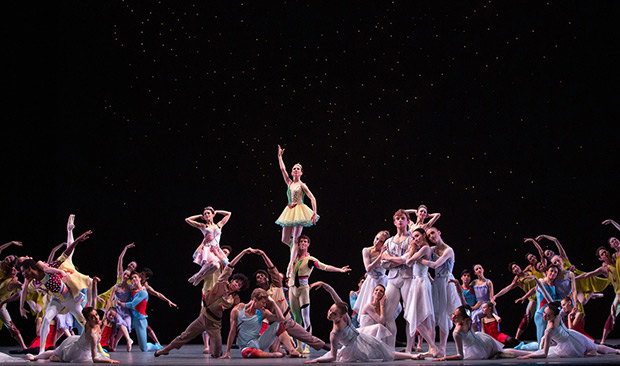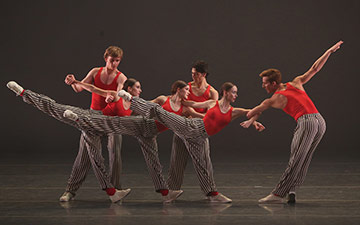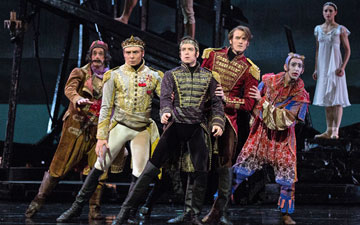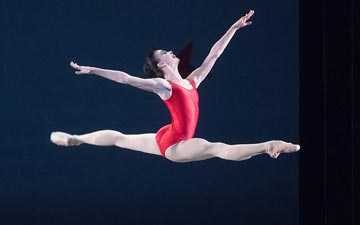
© Marty Sohl. (Click image for larger version)
American Ballet Theatre
Gala: Serenade After Plato’s Symposium, The Seasons
Ratmansky Trio: Songs of Bukovina, On the Dnieper, The Seasons
★★★★✰
New York, Metropolitan Opera House
20, 21 June 2019
www.abt.org
www.metopera.org
Anniversary Dances
It’s Ratmansky week at American Ballet Theatre. On Monday, at the spring gala, the company performed his newest work, The Seasons, set to Alexander Glazunov’s eponymous ballet score, composed in 1900 for Marius Petipa. On that night, it was paired with his 2016 ballet-as-Socratic-dialogue Serenade After Plato’s Symposium. Tuesday-Thursday, the company presents a triple bill: The Seasons and On The Dnieper, his very first work for ABT, from 2009; and the folk-tinged Songs of Bukovina, from 2017. Up next is his surrealist confection Whipped Cream.
It’s impossible not to be impressed by the range of these works, from introspective and conversational (Symposium) to brilliantly classical (The Seasons) to dramatic (Dnieper). Seeing them side by side one realizes how lucky ABT is to have a choreographer of Ratmansky’s stature and imagination in its midst, producing work after work, pushing and shaping the dancers: dramatically, technically, stylistically. As one watches them one gets the impression that he has revealed the dancers to themselves, awakening them to their own abilities and expressive range. There is no comparison between ABT today and ABT ten years ago.

© Marty Sohl. (Click image for larger version)
That is reason enough to celebrate. At the gala, a shower of confetti fell over the embarrassed but beaming choreographer and the gathered company after the grand finale of The Seasons. The Seasons is itself a celebration: of ballet, of the individual dancers and the company as a whole, of Petipa, of music, and the joy of dance. The ballet is a divertissement, i.e. a suite of dances embroidering on the theme of ice, flowers in bloom, the harvest, swallows in flight. As Ratmansky told the dancers in a rehearsal — I watched several rehearsals in the course of the ballet’s creation — “there is a mystery about the seasons, a divine energy. It’s more than pretty dances.” What the ballet seems to capture is the energy and life-force that drives the music: color, texture, rhythm, and the emotions they evoke.
It’s a ballet bursting with ideas, mainly about ballet and the profusion of which classicism is capable. Throughout, the corps plays an important part, augmenting, framing, complementing, and echoing the action. It’s difficult at times to choose whether to watch the corps or the principal dancers. This is a typical choice one has to make with Ratmansky’s work—there is always more to see. (A quality that invites return visits.) It is clear just how much he has learned from Petipa through his recent “reconstructions” of various ballets, among them Harlequinade and La Bayadère. I recognized a beautiful move from Harlequinade, a slow développé to the side while tilting the upper body sumptuously in the opposite direction; a sprightly little side tap from Gamzatti’s variation in La Bayadère; a lusty male dance with swinging arms that evokes the “danse infernale,” also in that ballet; a riff on the Rose Adagio from Sleeping Beauty.
But Ratmansky also expands the vocabulary of classicism in subtle and not-so-subtle ways. In the slow, rhapsodic pas de deux (performed by Isabella Boylston and James Whiteside at the gala, and Stella Abrera and Thomas Forster on the following night), he has the woman and man execute the same opulent step, a tour en l’air followed by a high développé to the side, swinging down to a little hop and opening of the other leg. Later, the woman partners the man in a series of finger turns. Or earlier, when a group of “poppies” — girls from the company school — joins the waves of dancers spreading across the stage; they are partnered both by the men and by the female corps, creating an image of the continuity of ballet over the generations. One of the solos, for “Hail” (performed on opening night by Catherine Hurlin) is so fast and so whirling that you think the dancer might spin offstage entirely. In another passage the corps darts side to side while four women execute turns with the leg out to the side while the man in the center does one spinning jump after another. It’s like watching a fantastical machine with multiple moving parts, all whirring at once.

© Marty Sohl. (Click image for larger version)
But it’s not just steps, it’s also the full-bodied musicality in the dancing that impresses; bodies responding and reacting to the music, not generically, but with details of phrasing that course through the arms, backs, shoulders, fingers, and eyes of the dancers. Even a lingering after-echo of a chord finds expression in the dance; at the end of a phrase, Winter (Aran Bell; Joo Won Ahn) lowers Ice (Hee Seo; Devon Teuscher) to the floor, and then, as the note begins to fade, rises on the ballet of the foot in an attitude, reaching upward, capturing the last glimmer of sound.
In short, The Seasons is a joy, and a ballet to return to again and again. Its imperfections lie in the peripherals: the costumes, by Robert Perdziola, and the lighting, by Mark Stanley. Perdziola, whose designs for Harlequinade were so imaginative and gorgeously detailed, seems to have completely lost his way here. There’s no unifying theme, color scheme or silhouette. The dresses, tutus, and unitards (for the men) look like a collection of clashing leftovers from other ballets. The lighting is uninspired, lacking the contrast and vivid color that is so present in the choreography. I would add another detail: to my eye, some of the action should happen further downstage, closer to the audience; the Met stage is awfully deep. Still, these are superficial issues; they can be fixed.

© Rosalie O’Connor. (Click image for larger version)
It was good to see Serenade After Plato’s Symposium again; the way it lays out dance steps as a form of conversation is as remarkable today as when it premiered in 2016. The gala cast was led by Tyler Maloney, replacing an injured Herman Cornejo. Maloney, who as a child danced the role of the Nutcracker Boy in Ratmansky’s 2010 production, has grown up dancing in his ballets. Though still in the corps, he is already an impressive dancer: detailed, precise, centered. All he lacks is star power, but I suspect that will come. (He still looks like a kid.) His soliloquy at the start of Symposium was exactly right: limpidly executed, introspective, fluent. He addressed each of his companions in turn, moving his arms in a zig-zag to make his point. Later, he performed a super-quick, skittering solo, tracing a wide arc around the stage; then did it again, in reverse. The steps fit like pinpricks into Leonard Bernstein’s virtuoso violin passage.
The men converse, compete, console one another. Their companionship and love is the theme that binds the dance together. In an extraordinary moment, Calvin Royal III dances a sorrowful soliloquy, bending deeply, arching his back, falling to the ground. The others approach, bourréeing on one by one, arms extended, like nocturnal moths or fairies. Royal “explains” his feelings to them, moving his arms; the men raise him up and then gather in a beautiful curving shape, as in a multiple embrace.

© Gene Schiavone. (Click image for larger version)
The following night, On the Dnieper returned after almost a decade out of repertory. The music, by Prokofiev, was composed for Serge Lifar in 1932, and made into a ballet for the Paris Opera. It didn’t last long, and, even now, there is something about the score that doesn’t quite work as a ballet, beautiful and churning as it is. Its sound world lies somewhere between Prodigal Son and Romeo and Juliet, but it lacks Prodigal’s momentum, and Romeo’s sweep. Somehow it keeps weighing down the steps. And the individual sections are too long, which forces Ratmansky into creating overly long expositions for each of the characters. To me, On the Dnieper is a flawed ballet with beautiful moments, a prelude to the more successful Romeo and Juliet he created years later for the National Ballet of Canada and the Bolshoi.
The story is a moving one: a soldier returns to his Ukrainian village from the First World War, hoping to reunite with his family and his former love. Once home, he falls in love with someone else, on the eve of her arranged marriage. Many hearts are broken. Ratmansky shows the conflict with great sensitivity; the most powerful passages in the ballet are the ones that illustrate different forms of sorrow and loneliness. His meeting with his mother (Nancy Raffa), who rushes to meet him like a shadow from beyond the grave, grips the heart. As does the image of a young woman being forced into a marriage she doesn’t desire; she and her betrothed stand with their backs to the audience, stiff-shouldered, as their guests carouse and their parents congratulate each other, clueless. Lives are being ruined. Simon Pastukh’s design, of cherry trees in bloom and fences—separating lover from lover—add to the emotional resonance of the scene. Cory Stearns, as the soldier, is grave, direct, wounded.

© Rosalie O’Connor. (Click image for larger version)
It’s fascinating to see Dnieper in the context of the newer works, to see how much Ratmansky has grown and developed in his time at ABT. Songs of Bukovina, a much slighter ballet than Dnieper, reveals a sophistication that the earlier ballet hadn’t yet achieved. This ballet on folk themes, set to piano pieces by Leonid Desyatnikov (inspired, in turn, by folk music from the region of Bukovina) is a little jewel: enigmatic, strange, rhythmically varied, sprinkled with resonant images and memorable but un-emphatic steps. I love how the first notes on the piano (played fluently by Jacek Mysinski) appear to call the dancers, almost against their will, onstage. Later, a man, perhaps a soldier, marches, almost in a dream, or a nightmare, fighting against an invisible force. Blaine Hoven was tremendous here, adding little pauses for emphasis; something in his dancing suggested the soldier of death in Kurt Jooss’s The Green Table. A woman, danced here by Isabella Boylston, bursts into little jumps, legs bent under her, as if her body were reacting to an electric current in the ground. The others watch, in disbelief. The steps are surprising, but also filled with meaning; they suggest stories and emotions, the meaning of which we must figure out for ourselves.
If there is one thing that binds together these works, it’s that. A mystery behind the steps. It’s more than just pretty dances.

















You must be logged in to post a comment.